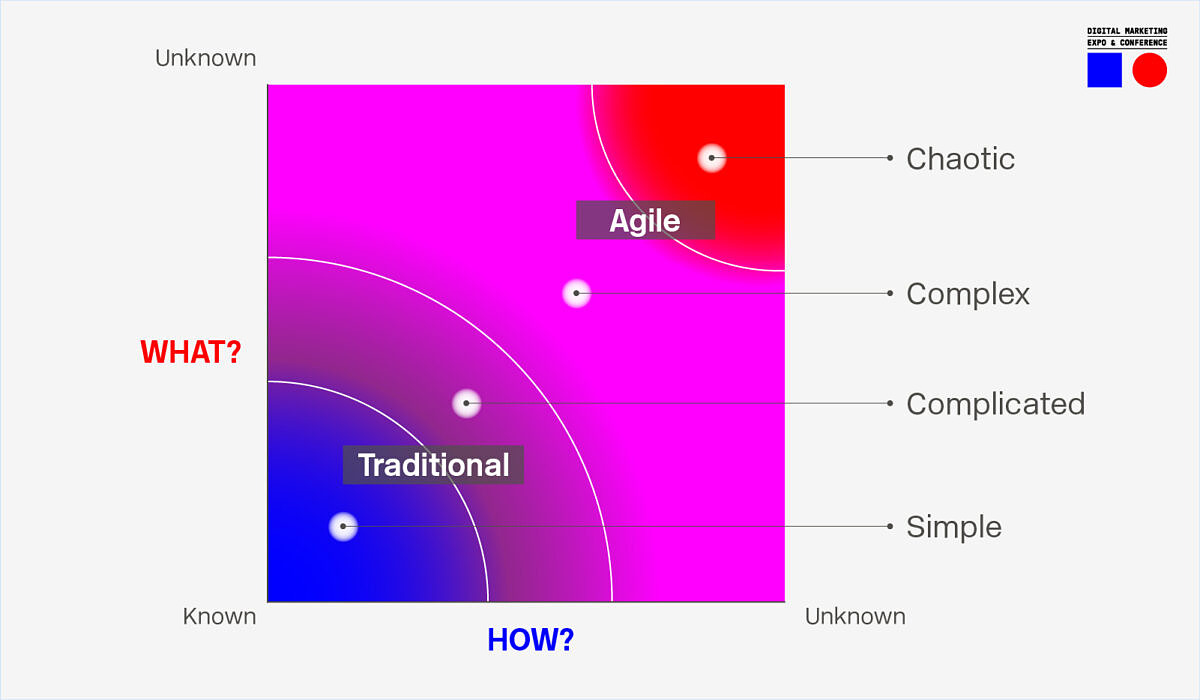How the Stacey matrix is the foundation for your project management approach
Agile working may be touted as the silver bullet for efficient project planning and workflows, but taking the traditional approach can also help you achieve your goal quickly. This matrix will show you which method is right for you.

How everyone became agile
What is the key to successful project management? Ideally, a clear objective and a team that will achieve it on schedule. That sounds pretty straightforward, doesn’t it? But what happens if you don’t have enough information about the project requirements, or if the team doesn’t have access to the right skills needed to implement the project?
“Then we have to rethink things!” And that’s how agile working started. Put simply, all the term means is adapting to the prevailing circumstances and taking a flexible approach to project planning – i.e. being agile. The initial models were created more than 20 years ago with a very defined objective: supporting agile project management in software development.
No longer simply a trend, more and more companies are requiring their employees to work in teams using agile methods. These days, our world is in flux and we see the options changing from day to day, so who wants to apply traditional project management strategies?
Let’s examine this more closely: agile working methods are not always the best fit and they aren’t necessarily better than traditional ones. The Stacey matrix shows you various approaches that you can use for your project management, so that you can make your team more efficient and achieve the objectives on schedule.
Make a decision! The Stacey matrix is here to help
The Stacey matrix was developed by Ralph Douglas Stacey, a British Professor of Management. The matrix aims to help with making decisions in project management.
What approach to choose is the fundamental question in project planning: do you implement agile planning strategies and working methods, or use standards to guide you?
Stacey presents the objectives and requirements in the context of the options for implementation:
- Requirements/objectives: what do you want to achieve?
Processing customer complaints, developing a software program, introducing a new insurance product, building a raft, and so on. - Options for implementation: what do I need to achieve it?
Technology, team knowledge, tool kit, etc.
The vertical axis shows the value for clarity about a project: Are all stakeholders clear on what the objective is? The horizontal axis shows how certain or uncertain the route is to achieving the goal, with four scenarios ranging from “simple” to “chaotic”. This shows that these scenarios require a variety of methods for successful project planning.

Robinson Crusoe and the matrix
Let’s use the following scenario as an illustration: your company is given the assignment “Build us an oceangoing raft in ten days”. If you have 20 expert raft builders in your team, then completing the job on schedule shouldn’t be a problem. All you have to do is bring in your tried and tested resources and your team members can get to work with their trusty tools. A team like this would have come in very handy for that lonely man on his island.
Unfortunately, project planning and management rarely run as smoothly as in that example. Digitalization in particular has presented many companies and business partners with a host of challenges, since digital transformation frequently involves imbalances between stakeholders. If the project stakeholders don’t have the same level of technology, then the significant increase in uncertainty about the issue of HOW can very quickly complicate something that was simple.
Why keep things simple if you can complicate them: Using the Stacey matrix to achieve your goal
If you’re tackling a new project and you need to know where you are with your team and equipment, then consult the Stacey matrix.
Here are four scenarios:
- “Simple”: You have previous experience in this type of this project and the problem-solving approach is also routine. Standard processes are appropriate here, using helpful resources such as pre-prepared checklists. Traditional working methods aren’t outdated in this scenario; they are simply the most effective choice.
- “Complicated”: Project planning involves a range of variables and the entire problem-solving approach is not immediately predictable. Conducting a detailed analysis of the requirements is time-consuming but worthwhile, as it will produce more clarity and thus allow tasks to be assigned efficiently. You may want to use a Kanban board as an agile project management tool to optimize your workflow. If the raft has to be made out of painted rubber pontoons instead of wood, for example, then you will need to plan and calculate from scratch again.
- “Complex”: In this scenario, the requirements and problem-solving approaches are no longer clear. Too many variables are involved, so predicting the individual steps in the workflow is impossible. In this case, agile working means “learning by doing”, including when it comes to forming the team. Complex settings tend to involve larger projects that have significantly more employees on board. Agile working methods such as the Spotify model or SCRUMS can help to add more structure to the workflow. If you are tasked with building a houseboat instead of a raft, for example, then you also need to understand the options for installing a kitchen unit so that it works properly.
- “Chaotic”: Welcome to agile project management in the Stacey matrix. This is where innovation is king – and that can definitely be a positive thing. We recommend keeping the iterative cycles short for this kind of agile project; in other words, sharing as many interim results as possible with the clients, so that changes and modifications can be made while the project is running. Being the project leader means you’re almost like Robinson Crusoe: you only have a vague idea of the materials you should be using to build something that will carry you and your team safely home over vast distances of open water. You simply start experimenting.
Applying the Stacey matrix
The Stacey matrix can help you decide what project management approach is most efficient for you and your team, from traditional through to agile, by clarifying ambiguities:
#1 What requirements and objectives does the project or assignment involve?
#2 Does the team agree on these objectives?
#3 What resources are you using to implement the project?
Agile project management yes, but not at any price
The Stacey matrix clearly illustrates that using agile methods is not always appropriate. If you have a well-coordinated workflow that uses standard methods to deliver results with a consistent quality level, then you should stick with traditional project management. More openness when structures are operating efficiently can actually lead to more mistakes, and there is also the risk that agile project management can cause you to lose sight of the full overview.
On the other hand, projects where the problem-solving approach is still not clear require you to be more open to agile working, since there are very few standards – if any – that you can apply. This is where agile project management tools like Kanban, the Spotify model, OKR and Scrum can be used for planning and implementation. In other words, where the project status moves from complicated to complex, you should consider familiarizing yourself with these agile tools, if you haven’t done so already.





